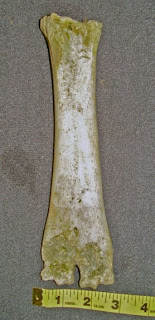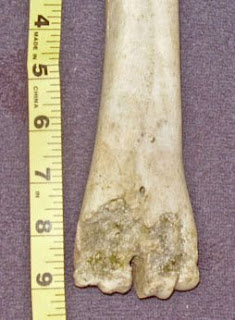They call me Mr. Tibia*
(* shamelessly stolen from my friend George, whose lightning wit and linguistic facility I've always admired and envied.)
Or rather, I'm very, very grateful that they *don't*.
To back up a bit and explain, I'm currently teaching anatomy, physiology, and pathology at a massage school in Tacoma. Thursday a week ago, I had introduced the skeletal system, and since I've always preferred hands-on, experiential learning to just lecturing at the students, Mr thalarctos and I combined our efforts.
The night before class, he bought a whole chicken, and prepared it in his trademark way, but before cooking it, he surgically removed an entire leg, taking care to keep the joint and ligaments intact. He then removed the meat from the bones, leaving the periosteum for the students to see. It still flexed and extended in a perfectly functional way, if not under its own power.
I took it in the next day to class, and had everyone observe the bone, the hyaline cartilage, the joint, the ligaments, the periosteum. Then, once everyone had had a chance to see how it operated intact, I gave it a third-degree sprain so that we could all have a look inside.
So after we had finished observing, and after explaining how anatomy classes in medical schools often had ceremonies to show appreciation for those who donated their bodies so that others could learn [1-6], and how some native Americans thanked their prey before the hunt for the sacrifice it would make for their benefit, we expressed gratitude for the chicken whose death had provided not only a delicious meal, but also had helped the students gain knowledge, and then we gave the bones a "burial" in the garbage can. I moved on to prepare the notes for the next week's lesson on skeletal system pathologies.
When we met again next week, one of my students handed me a baggie with a dry, dusty bone in it. Smiling, she said she had brought it so I could do a little better than chicken bones for teaching---she had taken it away from her dog, who had dug it up in the woods near her home.
I was touched by her kindness, but as I took the baggie and looked at the bone, I started to feel just the least bit uneasy---it was clearly a tibia, and although it was a little thicker than I would expect, with a groove running down the front that I didn't remember from any tibia I had ever seen, I couldn't say with certainty that it wasn't human.

So what *is* the proper etiquette when you think you may have inadvertently received human remains as a gift from a well-meaning student? Never having considered that question before, I dropped by the police station on the way home to find out their thoughts on the matter.
At the small suburban police station I stopped at, there was an older male civilian volunteer at the information desk. He greeted me in a friendly way, but his interest really ramped up when he saw what I was carrying, and he went into the back to get an officer.
Officer McIvor was very reassuring and professional, and assured me--despite my concerns that maybe I just watched way too much Law & Order, that bringing it in was the right thing to do, even though it probably was not human---like me, he was not the person to do the rule-out, but their bone guy could help. He asked me if I wanted it back, which I did, as long as it wasn't evidence or something, so he took it and gave me his card. In passing, he observed that it had been quite chewed up by something or other.


He called early the next morning, and left a message---a doc at Overlake Hospital had verified that it was, indeed, a tibia, and it was not a human one, so my bone would be waiting for me to pick it up at City Hall. They don't have a comparative osteologist on staff---once it's ruled out as human, they lose interest in it---so I don't have a species, just a rule-out as a non-human mammalian tibia. Maybe the staff at the Burke Museum has someone who can get a little closer; right now, I'm guessing "bear", but it's just an uninformed guess.
It was a relief that someone's loved ones weren't about to undergo a horror, and that I had not dragged my student into a murder investigation (and she had not dragged me into one!) just because of a spontaneous gift. And now I have a tibia to pass around for future anatomy lectures on the skeletal system.
My friend Brian, an anthropologist specializing in human osteology by training, observes that it's almost never human (and he's got tons of stories, like how people call in to report the discovery of a child's hand, only to have it turn out to be a raccoon). But I had to check.
[1] Eze O, Horgan F, Nguyen K, Sadeghpour M, Smith AL. The 2008 anatomy ceremony: voices, letter, poems. Yale J Biol Med. 2009 Mar;82(1):41-6.
[2] Elansary M, Goldberg B, Qian T, Rizzolo LJ. The 2008 anatomy ceremony: essays. Yale J Biol Med. 2009 Mar;82(1):37-40.
[3] Yale University School of Medicine Students. The 2007 anatomy ceremony: a service of gratitude: I: collected experiences. Yale J Biol Med. 2007 Jun;80(2):83-90.
[4] Kim Y, Sandoval A. The 2005 Anatomy Ceremony: a Service of Gratitude. Yale J Biol Med. 2005 Jan;78(1):83-9. No abstract available.
[5] Morris K, Turell MB, Ahmed S, Ghazi A, Vora S, Lane M, Entigar LD. The 2003 anatomy ceremony: a service of gratitude. Yale J Biol Med. 2002 Sep-Dec;75(5-6):323-9.
[6] Weeks SE, Harris EE, Kinzey WG. Human gross anatomy: a crucial time to encourage respect and compassion in students. Clin Anat. 1995;8(1):69-79.
Labels: comparative anatomy, teaching

0 Comments:
Post a Comment
<< Home